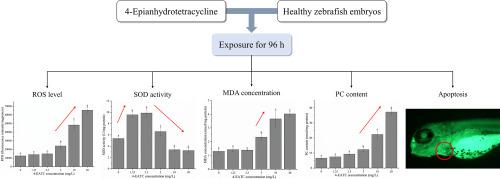Science of the Total Environment ( IF 8.2 ) Pub Date : 2021-07-14 , DOI: 10.1016/j.scitotenv.2021.149047 Meng Wang 1 , Jianfu Zhao 2 , Lingling Wu 3 , Taowu Ma 1

|
4-Epianhydrotetracycline (4-EATC) is a major intermediate product of tetracycline during its degradation progress in the natural environment, which is frequently detected in aquatic environments and poses a potential threat to aquatic organisms. In the present study, the ecotoxicity of 4-EATC have been studied from the perspective of oxidative stress by using zebrafish embryos. After 96 h exposure, the reactive oxygen species (ROS) levels, malondialdehyde (MDA) concentrations and protein carbonyl (PC) contents in zebrafish embryos in the lower-concentration 4-EATC treatment groups (1.25 mg/L and 2.50 mg/L) showed no significant differences compared with the negative control group. However, the total superoxide dismutase (SOD) activity was increased significantly. After exposed to the higher-concentration of 4-EATC (5.00, 10.0 and 20.0 mg/L) resulted in a significant increase in ROS levels, MDA concentrations and PC contents, in contrast, a significant decrease in SOD activities. The results indicate that exposure to high concentrations of 4-EATC (5.00, 10.0 and 20.0 mg/L) could disrupt the redox equilibrium in zebrafish embryos, leading to the occurrence of oxidative damage. Apoptosis of the embryonic cells could be induced by 4-EATC exposure at different concentration and the rate of apoptosis enhanced with the increase of 4-EATC concentration. The pericardium was the most frequent site of apoptosis. The present study points out that more attention should be paid to the potential ecological risks of antibiotic degradation products.
中文翻译:

4-表氢四环素对斑马鱼(Danio rerio)胚胎氧化应激的影响
4-表氢四环素(4-EATC)是四环素在自然环境中降解过程中的主要中间产物,在水生环境中经常被检测到,对水生生物构成潜在威胁。在本研究中,利用斑马鱼胚胎从氧化应激的角度研究了 4-EATC 的生态毒性。暴露 96 小时后,低浓度 4-EATC 处理组(1.25 mg/L 和 2.50 mg/L)斑马鱼胚胎中的活性氧 (ROS) 水平、丙二醛 (MDA) 浓度和蛋白质羰基 (PC) 含量与阴性对照组相比无显着差异。然而,总超氧化物歧化酶 (SOD) 活性显着增加。在暴露于更高浓度的 4-EATC(5.00、10.0 和 20. 0 mg/L) 导致 ROS 水平、MDA 浓度和 PC 含量显着增加,相反,SOD 活性显着降低。结果表明,暴露于高浓度的 4-EATC(5.00、10.0 和 20.0 mg/L)会破坏斑马鱼胚胎中的氧化还原平衡,导致氧化损伤的发生。不同浓度4-EATC暴露可诱导胚胎细胞凋亡,且随着4-EATC浓度的增加,细胞凋亡率增加。心包是细胞凋亡最常见的部位。本研究指出,应更加关注抗生素降解产物的潜在生态风险。结果表明,暴露于高浓度的 4-EATC(5.00、10.0 和 20.0 mg/L)会破坏斑马鱼胚胎中的氧化还原平衡,导致氧化损伤的发生。不同浓度4-EATC暴露可诱导胚胎细胞凋亡,且随着4-EATC浓度的增加,细胞凋亡率增加。心包是细胞凋亡最常见的部位。本研究指出,应更加关注抗生素降解产物的潜在生态风险。结果表明,暴露于高浓度的 4-EATC(5.00、10.0 和 20.0 mg/L)会破坏斑马鱼胚胎中的氧化还原平衡,导致氧化损伤的发生。不同浓度4-EATC暴露可诱导胚胎细胞凋亡,且随着4-EATC浓度的增加,细胞凋亡率增加。心包是细胞凋亡最常见的部位。本研究指出,应更加关注抗生素降解产物的潜在生态风险。不同浓度4-EATC暴露可诱导胚胎细胞凋亡,且随着4-EATC浓度的增加,细胞凋亡率增加。心包是细胞凋亡最常见的部位。本研究指出,应更加关注抗生素降解产物的潜在生态风险。不同浓度4-EATC暴露可诱导胚胎细胞凋亡,且随着4-EATC浓度的增加,细胞凋亡率增加。心包是细胞凋亡最常见的部位。本研究指出,应更加关注抗生素降解产物的潜在生态风险。












































 京公网安备 11010802027423号
京公网安备 11010802027423号